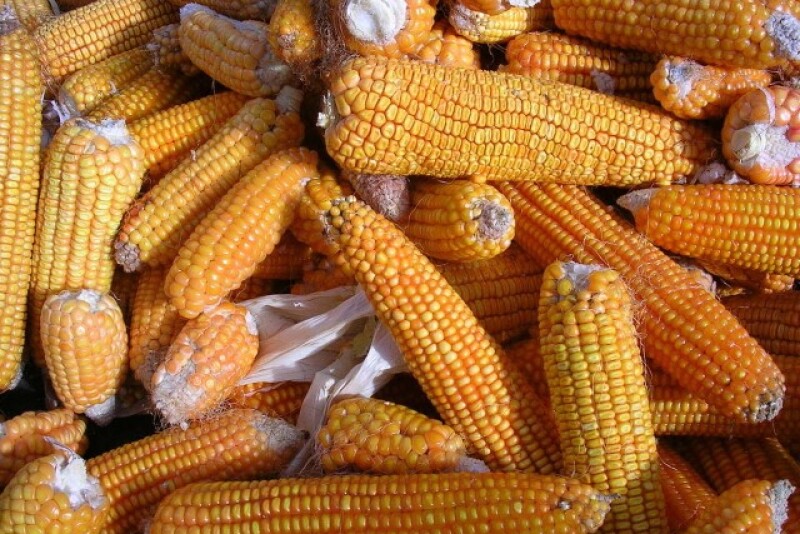Conventional wisdom holds that when U.S. corn acreage is large, national yields will be below trendline because farmers opted to plant on less-productive land.
With corn acreage at 95.2 million acres, 5% higher than last year, fringe acreage likely contributed to that higher number. However, given that Chicago Board of Trade December corn futures prices are down 7% since May, when farmers start planting corn, market participants are factoring in higher-than-trendline yields because of near-perfect growing conditions in the Corn Belt, says Sean Lusk, vice president at Walsh Trading.
“In the big producing states, they look like they’ll have bumper yields so far. You’re pricing that in now,” Lusk says, citing USDA’s National Agricultural Statistics Service’s Aug. 4 weekly crop condition report that puts 73% of the national corn crop in good-to-excellent condition.
On Tuesday, USDA will release its August crop report, the first survey-based view of the developing corn crop, and market participants are expecting a bin-buster.
Some private crop estimates, such as those from StoneX which is forecasting national corn yields at 188.1 bushels per acre, are well above USDA’s current 181 bpa trendline.
There is still plenty of growing season left and changes in weather could upend current yield estimates, but 2025 maybe the year the idea of reduced national corn yields on big acreage bucks the conventional wisdom.
Increased 2025 Acreage is Not all Fringe Land
Crop specialists want to debunk the idea that fringe land was responsible for the acreage increase. Frayne Olson, crop economist and marketing specialist with North Dakota State University extension, says some of the acreage bump came from the normal shifting of rotations between corn and soybeans and not just lower-yielding transitional land.
The added corn acreage was widely distributed, too, says Bob Nielsen, professor emeritus of agronomy at Purdue University. Of the 4.6 million more corn acres planted in 2025, 1.6 million were planted in the top five corn-producing states of Iowa, Illinois, Nebraska, Minnesota and Indiana, which produce 61% of the nation’s crop, with 1.7 million planted in the states that rank sixth to fifteenth in production terms, representing 33% of production.
“(It) seems to me that the effect of increased acreage on corn production in the Top 5 producing states might compensate for the increased acreage in the second and third group of states with generally, but not always, lower yields,” he says.
Using simple linear regression of corn yields since 1956, Nielsen estimates 2025’s U.S. trendline corn yield to be 186.2 bpa.
States to Watch
Two University of Illinois professors, Emerson Nafziger, professor emeritus, and Giovani Preza Fontes, assistant professor, crop sciences, say the crop ratings in states west and northwest of Illinois “are so far above normal that there’s little chance that corn yields won’t set records, at least in some states and probably in the U.S. Ratings are a little below normal east of the Mississippi, but not enough to offset the rest of the Corn Belt,” Nafziger says.
Daniel Quinn, assistant professor of agronomy and extension corn specialist at Purdue, says Iowa’s crop conditions stand out, with 85% in good condition. After a few years of reduced production, Iowa’s corn crop could bounce back strongly.
Fontes says while parts of southern Illinois received excessive rainfall in April and May, delaying planting, most of the late-planted fields are looking good. Illinois might not break 2024’s record of 217 bpa “there is no reason to doubt that we will be close to the trendline in Illinois,” he says.
Carl Zulauf, agricultural economist at The Ohio State University, says he’s watching Minnesota’s yield reports closely. Although it’s a top-five-producing corn state, being further north, “It’s not in the premium-growing area, so it swings more,” he says.
Market participants are also discussing the potential impact of prevent plant on crop size, and on Tuesday, USDA is expected to include a survey of how much land was unplanted.
Olson says concerns over how prevent plant acreage will affect national average yield misunderstand the difference between planted and harvested acres. Being in North Dakota his state often has prevent-plant acreage.
“When we think about planted versus harvested area, if it’s prevent plant, it’s considered unharvested…. So it’s not included in our yield,” he says.

